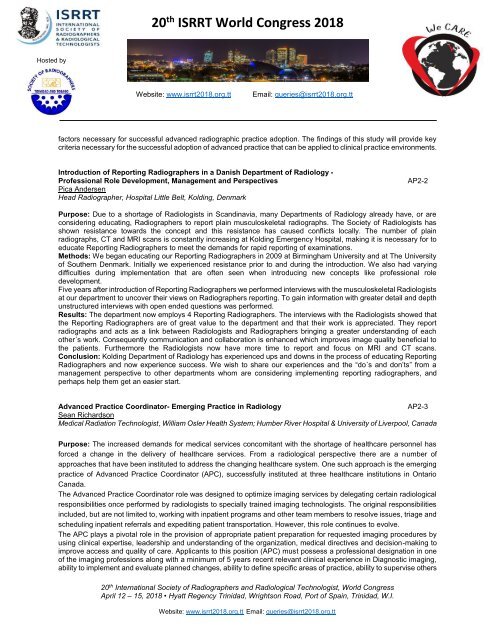Trinidad-and-Tabago-Congerss-Abstract-Book
You also want an ePaper? Increase the reach of your titles
YUMPU automatically turns print PDFs into web optimized ePapers that Google loves.
20 th ISRRT World Congress 2018<br />
Hosted by<br />
Website: www.isrrt2018.org.tt<br />
Email: queries@isrrt2018.org.tt<br />
factors necessary for successful advanced radiographic practice adoption. The findings of this study will provide key<br />
criteria necessary for the successful adoption of advanced practice that can be applied to clinical practice environments.<br />
Introduction of Reporting Radiographers in a Danish Department of Radiology -<br />
Professional Role Development, Management <strong>and</strong> Perspectives<br />
Pica Andersen<br />
Head Radiographer, Hospital Little Belt, Kolding, Denmark<br />
AP2-2<br />
Purpose: Due to a shortage of Radiologists in Sc<strong>and</strong>inavia, many Departments of Radiology already have, or are<br />
considering educating, Radiographers to report plain musculoskeletal radiographs. The Society of Radiologists has<br />
shown resistance towards the concept <strong>and</strong> this resistance has caused conflicts locally. The number of plain<br />
radiographs, CT <strong>and</strong> MRI scans is constantly increasing at Kolding Emergency Hospital, making it is necessary for to<br />
educate Reporting Radiographers to meet the dem<strong>and</strong>s for rapid reporting of examinations.<br />
Methods: We began educating our Reporting Radiographers in 2009 at Birmingham University <strong>and</strong> at The University<br />
of Southern Denmark. Initially we experienced resistance prior to <strong>and</strong> during the introduction. We also had varying<br />
difficulties during implementation that are often seen when introducing new concepts like professional role<br />
development.<br />
Five years after introduction of Reporting Radiographers we performed interviews with the musculoskeletal Radiologists<br />
at our department to uncover their views on Radiographers reporting. To gain information with greater detail <strong>and</strong> depth<br />
unstructured interviews with open ended questions was performed.<br />
Results: The department now employs 4 Reporting Radiographers. The interviews with the Radiologists showed that<br />
the Reporting Radiographers are of great value to the department <strong>and</strong> that their work is appreciated. They report<br />
radiographs <strong>and</strong> acts as a link between Radiologists <strong>and</strong> Radiographers bringing a greater underst<strong>and</strong>ing of each<br />
other´s work. Consequently communication <strong>and</strong> collaboration is enhanced which improves image quality beneficial to<br />
the patients. Furthermore the Radiologists now have more time to report <strong>and</strong> focus on MRI <strong>and</strong> CT scans.<br />
Conclusion: Kolding Department of Radiology has experienced ups <strong>and</strong> downs in the process of educating Reporting<br />
Radiographers <strong>and</strong> now experience success. We wish to share our experiences <strong>and</strong> the “do´s <strong>and</strong> don’ts” from a<br />
management perspective to other departments whom are considering implementing reporting radiographers, <strong>and</strong><br />
perhaps help them get an easier start.<br />
Advanced Practice Coordinator- Emerging Practice in Radiology<br />
AP2-3<br />
Sean Richardson<br />
Medical Radiation Technologist, William Osler Health System; Humber River Hospital & University of Liverpool, Canada<br />
Purpose: The increased dem<strong>and</strong>s for medical services concomitant with the shortage of healthcare personnel has<br />
forced a change in the delivery of healthcare services. From a radiological perspective there are a number of<br />
approaches that have been instituted to address the changing healthcare system. One such approach is the emerging<br />
practice of Advanced Practice Coordinator (APC), successfully instituted at three healthcare institutions in Ontario<br />
Canada.<br />
The Advanced Practice Coordinator role was designed to optimize imaging services by delegating certain radiological<br />
responsibilities once performed by radiologists to specially trained imaging technologists. The original responsibilities<br />
included, but are not limited to, working with inpatient programs <strong>and</strong> other team members to resolve issues, triage <strong>and</strong><br />
scheduling inpatient referrals <strong>and</strong> expediting patient transportation. However, this role continues to evolve.<br />
The APC plays a pivotal role in the provision of appropriate patient preparation for requested imaging procedures by<br />
using clinical expertise, leadership <strong>and</strong> underst<strong>and</strong>ing of the organization, medical directives <strong>and</strong> decision-making to<br />
improve access <strong>and</strong> quality of care. Applicants to this position (APC) must possess a professional designation in one<br />
of the imaging professions along with a minimum of 5 years recent relevant clinical experience in Diagnostic imaging,<br />
ability to implement <strong>and</strong> evaluate planned changes, ability to define specific areas of practice, ability to supervise others<br />
20 th International Society of Radiographers <strong>and</strong> Radiological Technologist, World Congress<br />
April 12 – 15, 2018 • Hyatt Regency <strong>Trinidad</strong>, Wrightson Road, Port of Spain, <strong>Trinidad</strong>, W.I.<br />
Website: www.isrrt2018.org.tt Email: queries@isrrt2018.org.tt


















